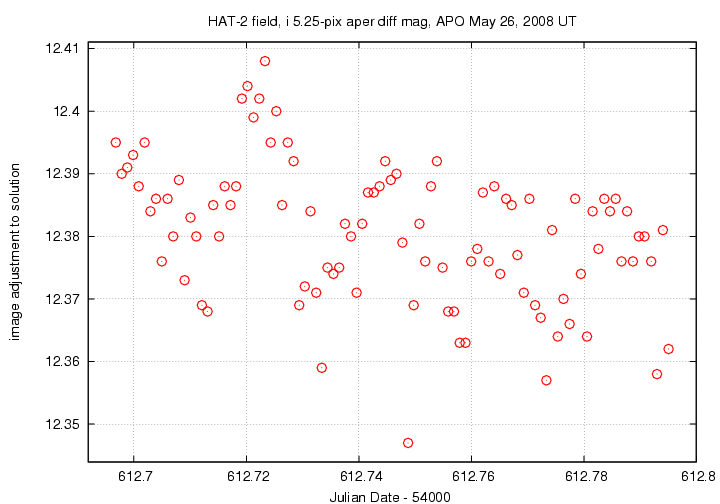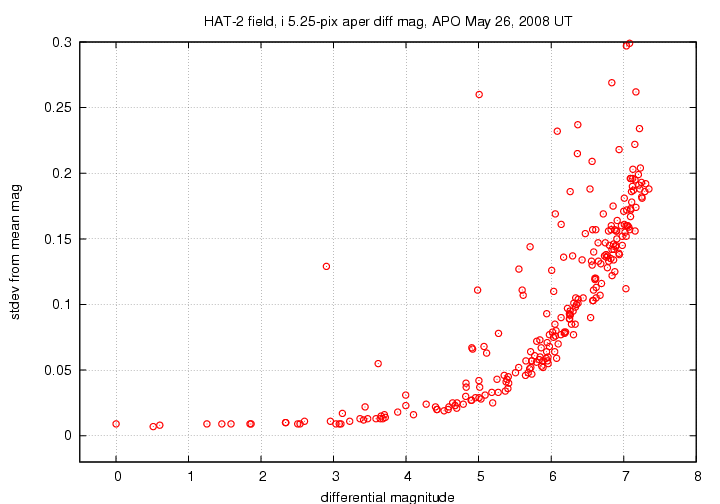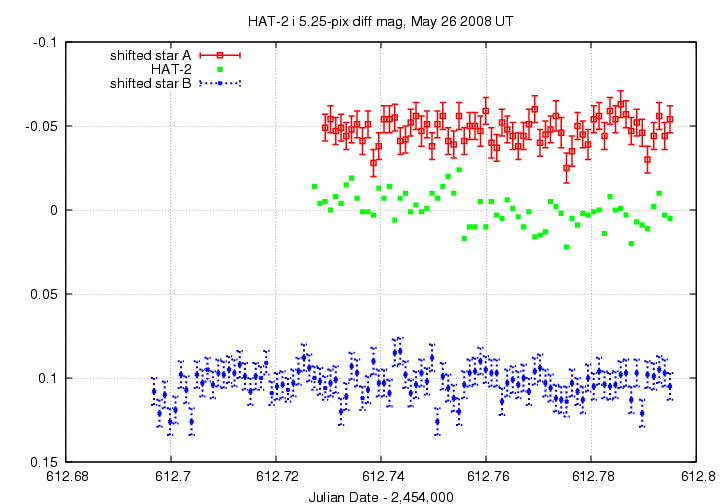
On the night of UT May 26, 2008, the SDSS Photometric Telescope ("PT" for short) took a series of exposures of HAT-2. We observed during the ingress only, obtaining noisy data which does not show an event clearly.
Notes from the night
This is a chart of the field. HAT-2 is the bright star indicated by the crosshairs.

The host star of HAT-2 has a magnitude V=8.7 according to HD147506b: A Super-Massive Planet in an Eccentric Orbit Transiting a Bright Star.
Following the procedures outlined by Kent Honeycutt's article on inhomogeneous ensemble photometry, I used all stars available in each image to define a reference frame, and measured each star against this frame. You can find the software package used to do the ensemble photometry online; it's free!
The night was very clear. The graph below shows the amount by which instrumental magnitudes from each image needed to be shifted to match the ensemble reference. On a clear night, this graph would show a straight horizontal line.

Below is a graph of the scatter in differential magnitude versus magnitude in the ensemble solution.

HAT-2 is the brightest star, at differential mag 0.00. It ought to show a small excess of scatter over neighboring stars of the same brightness, but does not. The "noise floor" in these measurements is about 0.008 mag -- due mostly to short exposure time, I think. The expected depth of transit is only 0.005 mag.
Below are the light curves for the target (green symbols) and some comparison stars in the field. Note that there are no measurements of the target star for the first half of the run; I don't know why.

In this closeup, I have shifted the data for two comparison stars to move them closer in magnitude to the target.

There appears to be a drop in the brightness of the target at around 612.755. I see no hint of a subsequent rise.
Justin's notes indicate that the ephemeris prediction is for ingress at 612.735, which is somewhat earlier than the apparent drop; however, the data is pretty noisy. The predicted egress is at 612.924, long after the end of the measurements.
You can grab the measurements for your own analysis. Below is a table with three flavors of time, plus the differential magnitude of the target and an estimate of the uncertainty in each measurement. I show the first few lines of the file to give you an idea of its format.
# Measurements of HAT-2 made with APO PT, May 26, 2008 UT. # Each exposure 3 seconds long in SDSS i-band; # Tabulated times are midexposure (FITS header time - half exposure length) # and accurate only to +/- 1 second (??). # 'mag' is a differential magnitude based on ensemble photometry # using a circular aperture of radius 5.25 arcseconds. # # UT day JD-2,450,000 HJD-2,450,000 mag uncert May26.72735 4612.72735 4612.73007 -0.014 0.007 May26.72838 4612.72838 4612.73110 -0.004 0.008 May26.72938 4612.72938 4612.73210 -0.005 0.007
Last modified 06/23/2008 by MWR.